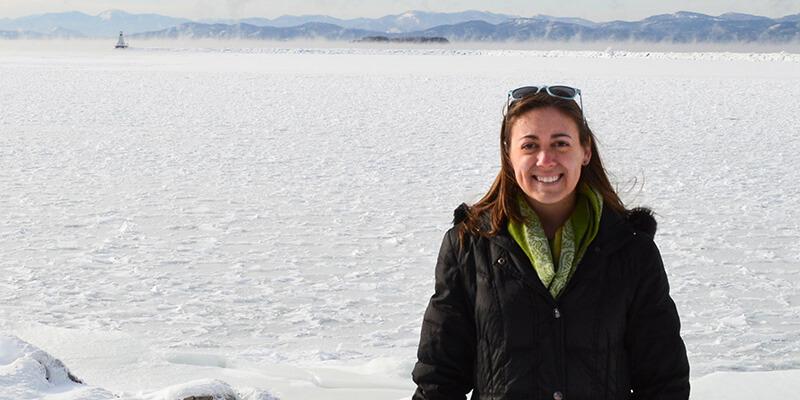University of Vermont graduate student Hannah Lachance had a day’s notice to write a 300-word essay to apply for a $2000 Women in STEM Scholarship from Universities.com. Asked to convey why pursuing a degree in science, technology, engineering, or math is important to her, she wrote candidly about her educational and work experiences and the challenges she faces as a woman in the science and technology fields.
She received word in mid-November 2017 that she had won the sole scholarship.
“In my essay, I described all the obscure and wonderfully disgusting opportunities I’ve had involving animals, guts, poop, and molecular genetics,” says Lachance, who graduated with a B.S. in animal sciences and a minor in wildlife biology from UVM in 2012 and gained experience in molecular genetics at the U.S. Military Academy in West Point and in UVM Professor Stephanie McKay’s epigenetics laboratory. “I emphasized the importance of advancing my education and expanding my skills to stand out as a viable candidate for STEM positions.”
Her work in animal sciences and wildlife conservation has included dissections of terrestrial and aquatic organisms, collection and analysis of hundreds of scat samples, and thousands of hours in laboratories investigating topics that range from microbes to genomes.
Lachance is a second-year master’s degree student concentrating in aquatic ecology and watershed science in UVM’s Rubenstein School of Environment and Natural Resources. She is applying her molecular genetics skills to a study of cisco, a cold water fish, and how changes in lake ice coverage related to climate change affect fish reproduction and development.
“Cisco require winter conditions, which typically include ice coverage, for their eggs to develop. The fish lay eggs in November and December, and the eggs hatch in spring around ice out,” says Lachance, who works with Professor Jason Stockwell, director of the Rubenstein Ecosystem Science Laboratory on Lake Champlain. “I am looking at differences in fish development at the molecular level that we observe at varying levels of light transmission through ice.”
“Hannah is a fantastic choice for the Women in STEM Scholarship,” says Stockwell. “Her research, like her career path, crosses many disciplines, and her story is a great example of how integrating STEM disciplines, and getting outside of your comfort zone, can prepare you for more opportunities in STEM careers.”
In December, UVM’s Gund Institute for Environment accepted Lachance as a Gund Graduate Student Fellow.
“I’m excited to network with interdisciplinary scientists, broaden my research ideas, and share my own skill set,” she says. “I hope to someday pay my successes in STEM education forward by helping to excite the next generation of STEM students about the fascinating world we live in.”
Universities.com is a technology company and a source for people to make informed decisions about pursuing a college or university education or an advanced degree. The annual Women in STEM Scholarship is open to qualified women who are pursuing an associate’s, bachelor’s, graduate, or professional degree at an accredited college or university.
